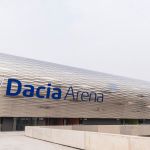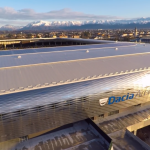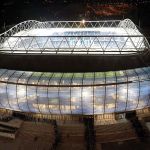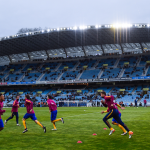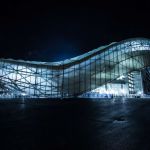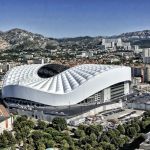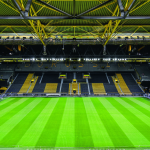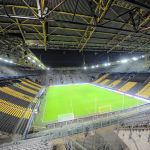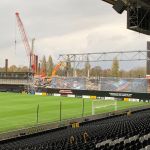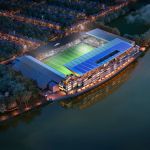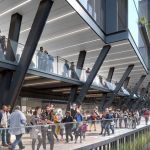
5 successful restyling of football stadiums
One for each European top championship (plus one)
January 25th, 2021
The case of the Franchi stadium involved many people. Politicians, managers, fans, architects. Practically, it has attracted so many social figures into a public debate, because, in fact, it is a discourse that has more meanings. It is a question of deciding what to do with a significant, beautiful and historical structure, but also old, dangerous, and unfroyed. That is why, on the one hand, there are those who have pushed for its culling, while on the other, those who have organized conferences and petitions to prevent their discharge. But is restyling really the best solution in these cases?
Antonio Cunazza, direct della rivista online Archistadia, explains that: "The general key to reading is that, where possible, trying to renovate the stadium (even transforming it) must be one of the priorities. The watchword I am convinced is 'transformation', which does not exclude erasing/redoing, but does not even place it as a first or only choice". He continues: "The case of the Marseille Vélodrome is a paradigm of this approach, having been reborn by itself 4 times in its history, but always in line with its past. But restyling can also mean constant renewal, as for English stadiums: think of Old Trafford, Anfield, Villa Park, all continuously expanded, and partly rebuilt, and always with improvement steps and respectful of the identity of the place".
1 - Dacia Arena, Italy (Udinese Calcio)
From the past, in addition to Zico, one thing had made Udinese and its home games famous: the arch of the Stadio Friuli - a reinforced concrete curve of 200 meters, moreover walkable inside. Built in 1976 by architects Giacomuzzi and Parmegiani, Friuli hosted Udinese's golden age in the 1980s, the World Cup in Italy 90, and the European phase of the club of the first two thousand (the one with Guidolin on the bench). In 2014, however, the stadium underwent a historic turning point. Three sides out of four are deconstructed and dismantled, and until 2016, the plant remains only with the central grandstand, the most important, the one with the arch. The restyling of Friuli has been indicative of how an aesthetically beautiful and functional modification can be, without necessarily conditioning the entire structure. The club - which bought the facility by renaming it Dacia Arena after completion of the works - kept the most architecturally interesting part - the arch and its grandstand - and remade all other sectors.
Now, the stadium still has that indistinguishable stretch that has characterized it for decades, while around it, it is a modern system with colorful seats, LED illuminations and services included in the outside of the structure. Of the series "like an English stadium".
2 - Estadio Anoeta, Spain (Real Sociedad)
As mentioned on Archistadia, the Anoeta of San Sebastian is an icon of stadium architecture. The reference of the name is precisely to the curvature of the stands, undulating, but it was also a little cumbersome for its extensive shape. In fact, the Anoeta had a wide athletics track surrounding the ground and, moreover, the stadium could not - as in many cases - meet the demands for services and resources that modern facilities should have instead. Thus, after a long bureaucratic process carried out by the management, the club completed the new Anoeta in 2019. The process of modernisation has not been very long, nor revolutionary. And yet, now the stadium is very different from before. The skeleton remained the same, but the stands were approached to the playing field covering the athletics track, and the stands, previously discovered, were corrected with total coverage.
The external side of the stadium has also been renovated, with spaces built to accommodate shops and refreshment services that facilitate even more the function of the Anoeta, urbanly fundamental in San Sebastian as it is close to a sports center, with other fields, indoor structures and near the inhabited center.
3 - Stade Velodrome, France (Olimpique Marseille)
As far as modernisation is due, perhaps no plant can have a better history than the Velodrome in Marseilles. Le Vel, as it is nicknamed, was inaugurated in 1937 and, until 2015, the date of the last modification, collected 4 different processes - in 1971, 1983, 1998, 2014. In fact, the stadium was born as a football stadium but with including an athletics track and a velodrome, then removed in the seventies. Subsequently, the facility was still too cumbersome for football and was further modified for the 1984 French European Championships, and this time, the space for bike races was also taken away. The most significant intervention, however, is the final intervention, of 2014. After numerous criticisms and a fatal accident, the OM kicks off the final restyling of the home system with a total white ball cover and new arrangement of the seats, implanted with an undulating course.
The stadium, which is now in the Elite category of UEFA stadiums, has a capacity of 67,000 seats and is the largest stadium in Ligue 1 (france, on the other hand, is the Stade de France).
4 - Signal Iduna Park, Germany (Borussia Dortmund)
In Germany, most stadiums have been restyling due to the World Cup hosted in 2006. Among them, one of the most important is the fourth largest stadium in Europe, Signal Iduna Park in Dortmund. Constantly modernized over the years, for the 2006 World Cup it was radically renovated: the magnificent facility that houses the Yellow Wall (the curve of Borussia fans) and that makes a show at every meeting, is mainly the result of the necessary operations in that period. The structure has always remained the same, but the seats, escape routes, lighting and exterior facades were all arranged (glass) before the German World Cup. One of the recent innovations, among those introduced in 2018, is the installation of a wi-fi system that is always active except when there is game time, so, viewers are less enticed to use smartphones and can pay attention to the match.
5- Anfield Road, England (Liverpool F.C.)
The magic of Anfield Road is unique, eternal, but even it cannot remain anchored in the past. In fact, in 2015, Liverpool also chose to change, and started a plan to renovate the Main Stand of the English plant, so as to go from a capacity of almost 46,000 spectators to more than 54,000 today. The new grandstand - which brought eight thousand more seats - vertically increased the size of the stadium: the club, in fact, added an more sector to the staircase creating a dome effect above the Main Stand. From the inside, the effect is very spectacular, despite the fact that the central stand is in this way higher than the other sectors of the stadium and differs greatly from the unitary effect of before - more similar to the setting of the home of the rival club, Old Trafford, with the much higher step of the Sir Alex Ferguson Stand.
Externally, the Main Stand has been renovated, although the base has remained the same, with glass and brick. The novelty, in fact, is that of the roof, which goes upwards and, like the canopies of the other sectors, still has iron arms running over it.
6 - BONUS TRACK - Craven Cottage, Englad (Fulham F.C.)
It will be completed in 2021, if there are no hitches, the Riverside Stand at Craven Cottage in London. The Fulham F.C. stadium is one of the premier league's most iconic as it still has regent columns between the seats. In fact, the club's project - designed by Studio Populous - is to expand the capacity of this sector of the stadium by raising its grandstand, but above all, filling it, on the outside, with a promenade, bars, services and rooms used for leisure and open even in the middle of the week. The classic combination of social impact and merchandising, in which, of course, Fulham F.C. will have its revenue from rents; but it will also benefit the neighborhood, thanks to the presence of the walkway that will join Bishop Park with the north side of the stadium, and urbanally, will make the area around the stadium even more functional in the economy of the Fulham district.








































.png)


.jpg)


.jpg)

























































